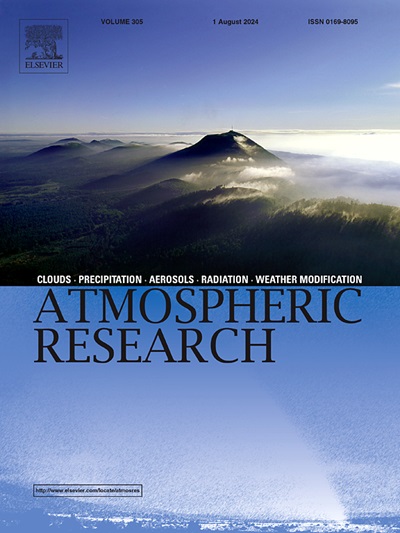Characteristics of orographic clouds and associated mechanisms in the Qilian Mountains, northeastern Tibetan Plateau based on FengYun-4A satellite TBB product
IF 4.5
2区 地球科学
Q1 METEOROLOGY & ATMOSPHERIC SCIENCES
引用次数: 0
Abstract
The Qilian Mountains (QM) in northwest China is a key source of orographic cloud formation, significantly influencing regional weather, climate, and hydrological balance. However, due to the sparse distribution of ground-based observational stations, the characteristics of orographic clouds and their associated precipitation remain insufficiently understood. Utilizing FengYun-4A black body temperature (TBB) data from 2018 to 2021 in boral summer, this study investigated the spatial and diurnal characteristics of orographic clouds and associated mechanisms over the QM. Results indicate that orographic clouds primarily form over the mountainous terrain, with deep convective clouds concentrated in the central and eastern QM. A distinct diurnal cycle is observed, with peak cloud activity occurring in the afternoon to early evening (15:00–19:00 local solar time), minimal activity late at night, and the weakest development in the morning. These variations are more pronounced in the central and eastern QM, where cloud formation persists for longer durations, compared to the western region. Three dominant diurnal cloud cycles are identified in the southeast, northeast, and eastern fringes of the western, central, and eastern QM, respectively, along with smaller-scale cycles along mountain ridges. Orographic cloud formation is driven by the convergence of low-level westerlies and the Asian monsoon, with moisture contributions from the westerlies, the Tibetan Plateau, and the monsoon system. Additionally, interactions between solar heating and complex terrain shape the spatial and diurnal distribution of these clouds. These findings enhance our understanding of regional water cycles and provide valuable insights for weather and climate research.
基于风云- 4a卫星TBB产品的青藏高原东北部祁连山地形云特征及相关机制
祁连山是中国西北地区地形云形成的重要来源,对区域天气、气候和水文平衡具有重要影响。然而,由于地面观测站分布稀疏,对地形云及其相关降水的特征仍然了解不足。利用2018 - 2021年夏季风云- 4a黑体温度(TBB)数据,研究了青藏高原地形云的空间特征和日变化特征及其相关机制。结果表明,地形云主要形成于山地上空,深对流云主要集中在高原中部和东部。观测到明显的日循环,云活动高峰出现在下午至傍晚(当地太阳时间15:00-19:00),深夜活动最少,早晨发展最弱。这些变化在QM中部和东部更为明显,与西部地区相比,那里的云形成持续时间更长。在QM西部、中部和东部的东南、东北和东部边缘分别确定了三个主要的日云周期,以及沿山脊的较小尺度的日云周期。地形云的形成是由低空西风带和亚洲季风的辐合驱动的,其中西风带、青藏高原和季风系统对水汽的贡献。此外,太阳加热和复杂地形之间的相互作用塑造了这些云的空间和日分布。这些发现增强了我们对区域水循环的理解,并为天气和气候研究提供了有价值的见解。
本文章由计算机程序翻译,如有差异,请以英文原文为准。
求助全文
约1分钟内获得全文
求助全文
来源期刊

Atmospheric Research
地学-气象与大气科学
CiteScore
9.40
自引率
10.90%
发文量
460
审稿时长
47 days
期刊介绍:
The journal publishes scientific papers (research papers, review articles, letters and notes) dealing with the part of the atmosphere where meteorological events occur. Attention is given to all processes extending from the earth surface to the tropopause, but special emphasis continues to be devoted to the physics of clouds, mesoscale meteorology and air pollution, i.e. atmospheric aerosols; microphysical processes; cloud dynamics and thermodynamics; numerical simulation, climatology, climate change and weather modification.
 求助内容:
求助内容: 应助结果提醒方式:
应助结果提醒方式:


